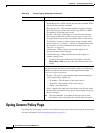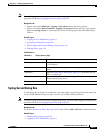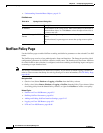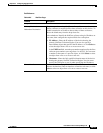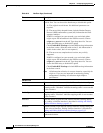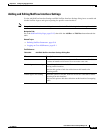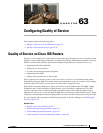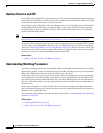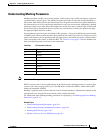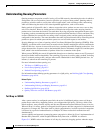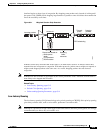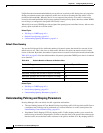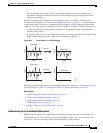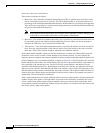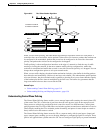
63-2
User Guide for Cisco Security Manager 4.4
OL-28826-01
Chapter 63 Configuring Quality of Service
Quality of Service on Cisco IOS Routers
Quality of Service and CEF
Cisco Express Forwarding (CEF) is an advanced Layer 3 IP switching technology that optimizes network
performance and scalability for all kinds of networks. It defines the fastest method by which a Cisco IOS
router forwards packets from ingress to egress interfaces.
Certain QoS features configurable in Security Manager, such as Class-Based Policing and Class-Based
Weighted Random Early Detection, are supported only on routers that run CEF. All routers from the
Cisco 800 Series to the Cisco 7200 Series require CEF for these QoS features; the Cisco 7500 Series
requires distributed CEF (dCEF).
Note For a complete list, see When is CEF Required for Quality of Service on Cisco.com at this URL:
http://www.cisco.com/en/US/tech/tk39/tk824/technologies_tech_note09186a0080094978.shtml
By default, CEF is enabled as part of the router’s initial configuration. To verify whether CEF is enabled
on your router, use the show ip cef command. You can configure CEF using the CEF interface settings
policy (see CEF Interface Settings on Cisco IOS Routers, page 59-24). Be aware, however, that if your
router does not have CEF enabled, activating CEF could have a significant impact on your router’s packet
streaming. Consult your router documentation before enabling CEF.
Related Topics
• Quality of Service on Cisco IOS Routers, page 63-1
Understanding Matching Parameters
You define matching parameters by identifying the traffic on which QoS is performed, that is, classifying
the interesting packets. Various classification tools are available, including protocol type, IP precedence
(IPP) value, Differentiated Service Code Point (DSCP) value, and ACLs.
Traffic classes consist of a series of match criteria and a means of evaluating these criteria. For example,
you might define a class with matching criteria based on several specified protocols and a DSCP value.
You can then specify that a packet must match only one of these defined criteria to be considered part of
this class. Your other option is to specify that packets must match all defined criteria considered part of
the traffic class.
Packets that are members of a defined traffic class are forwarded according to the QoS specifications
that you defined in the policy map. Packets that fail to meet any of the matching criteria are classified as
members of the default traffic class.
For information about defining matching parameters in a QoS policy, see Defining QoS Class Matching
Parameters, page 63-13.
Related Topics
• Defining QoS Policies, page 63-10
• Quality of Service on Cisco IOS Routers, page 63-1



